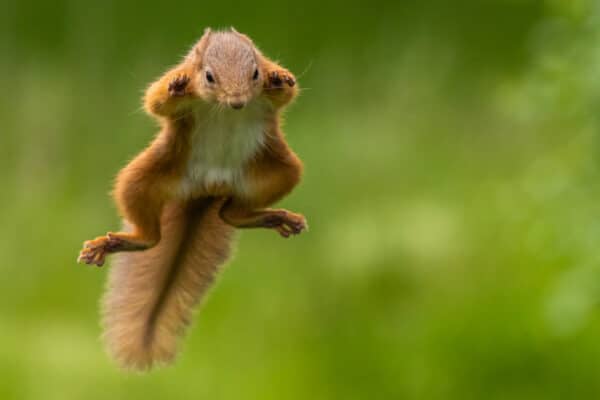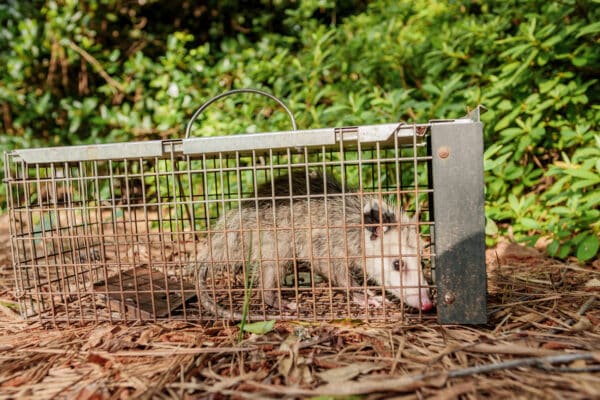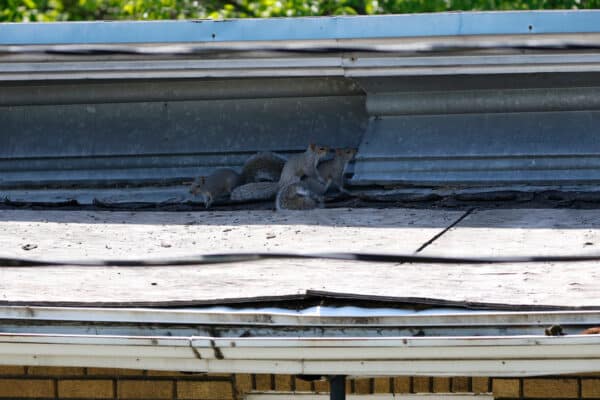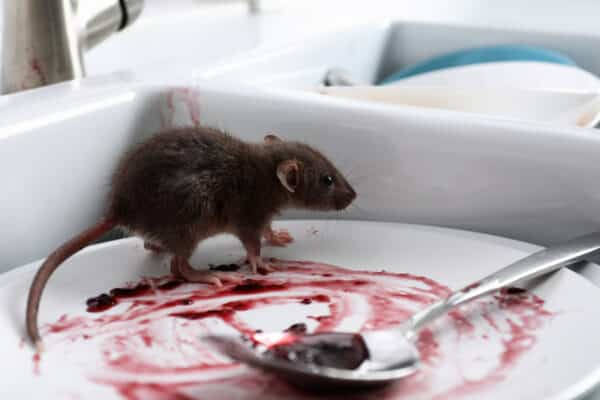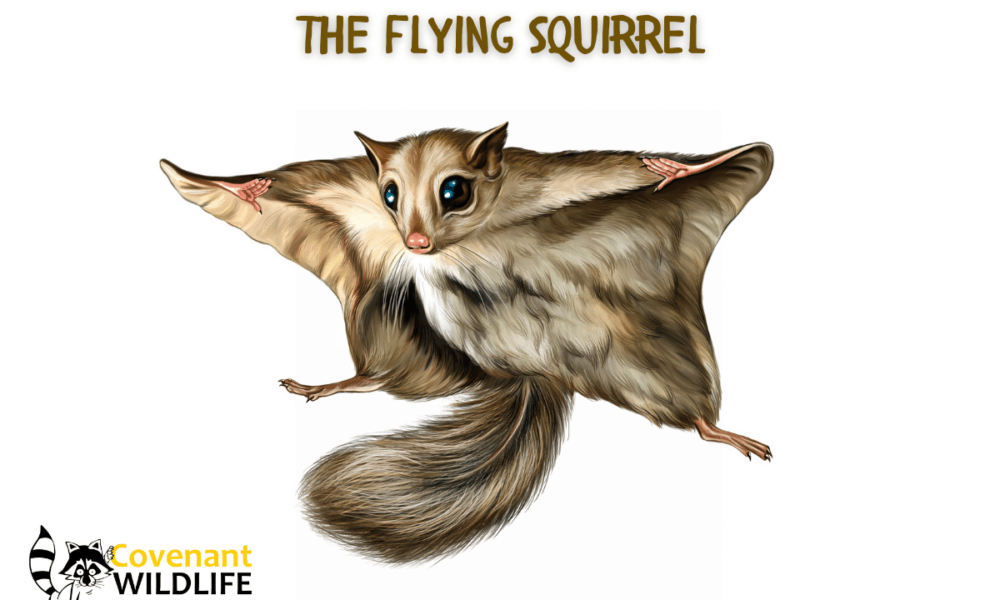
Well, that is a good question indeed. Some folks do keep flying squirrels as pets. But in the home, a wild flying squirrel can be a real problem.
Flying squirrels are actually very cute. The flying squirrel looks much like a ground or tree squirrel; they have a small round face, large eyes, big ears, and long fluffy tails.
With its body parachuting through the sky, you would probably be excited to see the feat of nature that is the flying squirrel. So, you can consider yourself lucky if you have ever seen a flying squirrel in nature.
And yes, they are adorable… until they are screeching through your home. At that point, you will want to know how to get rid of flying squirrels… and fast!
Warning: Killing flying squirrels may be illegal in your area. It is best not to go that route but to call for Wildlife Removal.
Flying Squirrel Facts
The tiny flying squirrel is a nocturnal rodent that is very playful. Acrobatic for sure, these squirrels can soar at great lengths from tree to tree. In fact, one single flight can span 150 to 500 feet. However, these highfliers do not fly; instead, they glide.
You see, the flying squirrel has what is called a patagium that extends in the shape of a square, acting like its wings or a parachute, more accurately. And, when they are flying, you may be able to catch the pink hue; they fluoresce… but you would need to have a UV light with you. And let’s face it, that doesn’t happen all too often.
If you do happen to go looking for the flying squirrel, they live in deciduous and coniferous forests and woodland areas. They will use rock crevices, tree cavities, woodpecker holes, snags, nest boxes, and abandoned nests for homes.
Keep reading to learn more about the flying squirrel.
Their Appearance
The flying squirrel is a brownish-gray squirrel. They are long-limbed critters with large eyes and bushy tails. Most importantly, the Patagium is a flap of fur-covered skin stretching from tiny wrist to tiny ankle. Then when stretched, it forms that square so the squirrel can glide high away from predators.
What’s more, the squirrel can control their direction and get to the next safe landing spot by dipping its hand or foot like an airplane’s wings.
The flying squirrel grows from 3 inches to 2 feet long, and they weigh between 3.5 and 5.5 pounds. Their lifespan is around five years long.
Oh, and these furry critters are both omnivorous and nocturnal. With their highly developed sense of smell, they come out at night to forage for food. Flying Squirrels eat seeds, nuts, tree sap, fruit, flowers, fungi, insects, and sometimes eggs.
Twice a year, flying squirrels will nest down to have their litter of pups around February and March. There they will have two to seven per litter per season. At five weeks, the pups are fully developed, and their flying skills are perfected by two and a half months.
At that point, they would build a nest comfortably in a tree. But if flying squirrels set their sights on your home, you have trouble for sure.

So, Are Flying Squirrels Dangerous?
The answer here is a resounding yes, and in more ways than one. But to understand, flying squirrels that have been domesticated are much more used to human interaction. But that is true with most pets that are raised to be in homes. They are handled from birth by trained individuals and are used to cages and human hands. Below are only some of the issues wild flying squirrels will create if they go unnoticed in your home.
Damage They Can Create
If a flying squirrel has nested in your home, there is no doubt they can do extensive damage. And if they do manage to trap themselves in your attic, here is what you can expect.
- Torn insulation for making a comfy, cozy nest.
- Urine, droppings, and shed fur that causes allergies.
- An increased risk of fire from chewed wires.
- Chattery activity and rapid reproduction.
But the last is one we hate to mention. You see, worst of all would be the smell of urine and the droppings everywhere. No one wants that from a colony of twenty flying squirrels.
Are There Any Health Threats?
There are few known health risks to flying squirrels beside the apparent foul ammonia odor and filth in your attic. Apparently, that may be why they make good pets for some who get them from a pet store or breeder.
They are not known to carry rabies. The one disease they can carry does not transmit to humans. That said, they do have lice, fleas, mites, and parasites.
Do You Have a Flying Squirrel Infestation?
If you walk around the home and see chew marks on the roofline and minor entry points, you may have a rodent or flying squirrel problem. Furthermore, you will find evidence of the critters through their tracks, droppings, and scent.
What will you hear? Late at night, you will listen to scratching and scurrying sounds. You may even hear their chatter, which sounds like chirping or clucking. They are very social creatures and will live in a colony of about 20 squirrels. So, if you see one, you most likely have an entire colony.
Preventing Flying Squirrels in your Home
Okay, one point we should mention here is that certain flying squirrels are protected in specific areas. Therefore, you really don’t want to chance harming one. However, you can prevent them from entering your home and making a mess.
Try the following things and then call a local wildlife control company to help with the rest.
- Cover any small holes and chew places with metal. If they return to try again, the metal will stop them.
- Use a wire mesh over all vent openings so they cannot climb in there.
- Seal any cracks or gaps leading to the attic or inside the home.
- Then, call your local wildlife removal company.
You can trust the professionals at Covenant Wildlife Removal to get rid of the flying squirrels for good. They can do the patch and prevention work for you. Then they can trap and remove the animals safely and humanely, locating them to an approved location.
The friendly staff at Covenant will also clean up the mess, disinfect and spray odor remover to get your home back to feeling clean again.
So, what are you waiting for? Trust the experts at Covenant Wildlife Removal today if you have a flying squirrel or any other wildlife issue in your home or yard.
Get Rid of Flying Squirrels
The nuisance of having an animal trapped anywhere in your home will cause anyone to want to exterminate the critters and get rid of the problem in a hurry. We get it. However, that is not recommended. For several reasons, we suggest you call for a wildlife removal company in your area.
Again, the flying squirrel is protected in some areas. So, you may need to check that out before you consider extermination. Here are the other ways to remove the flying squirrels.
Trapping a Flying
When most people talk about a trap, they set it on the ground in the vermin’s path. However, suspending a lure in mid-air is not usually what one does. To trap a flying squirrel, that is what you would need to do, in any case. They are rarely found on the ground and are impossible to catch in mid-air. Not to mention, lethal trapping is not at all cost-effective.
But that is where professional wildlife removal companies have the advantage. They already have all the equipment you will need to catch the pest safely. So, it will be less expensive in the end to have a trapper come out.
Using Poison
The simple truth here is that poison is not an option. You see, the toxin may be a time-saver for the homeowner, but it may not. It may get rid of the pest, but it may not. It may cause more problems than allowing the rodent to stay. Here is what we mean.
- Time Saver: Poison may kill the animal quickly, but it may only prolong death.
- Getting Rid of the Pest: It may rid you of the pest, but it may rid you of the family cat or another animal. There is no telling what animal may take the poison bait and end up dead in your home.
- Additional Problems: Poison may create more problems than you bargained for. A dead animal trapped in your attic or walls is no joke. It will stink up the entire home in a day or two, and the odor is tough to get rid of.
Covenant Wildlife Removal Removes the Flying Squirrels
You can trust the professionals at Covenant Wildlife Removal to get rid of the flying squirrels for good. They can do the patch and prevention work for you. Then they can trap and remove the animals safely and humanely, locating them to an approved location.
At Covenant Wildlife Removal, we will remove the squirrels, find the entry points and seal them up, and finally, clean up after them. We are fully equipped and experienced at getting to the source of the problem and eradicating the wildlife.
Flying Squirrel Removal Service includes:
- Trapping and Removal
- Clean Up
- Disinfection
- Odor Removal
- Repair of the area
Covenant Wildlife Removal is a top-rated local family-owned, full-service wildlife trapping, removal, and repair service. We can remove a rat infestation before it becomes an extensive problem for you and your family.
Contact us or call 205-850-5760 to set up an inspection.
